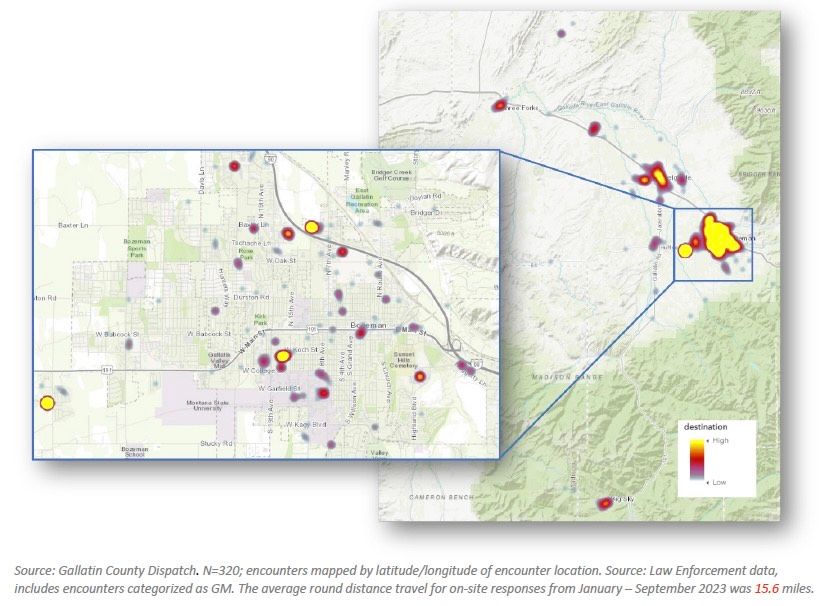News
Article
How Innovation Drives Access to Crisis Care in Rural Communities
Author(s):
Exploring new opportunities to offset the unique obstacles seen in rural communities.
Sean_AdobeStock

CRISIS CONNECTIONS
Innovations in health care are often the driving force behind improved access to care, especially in challenging environments like rural areas. Gallatin County, Montana, is a 2600-square-mile rural community with a population of 125,000.
The vastness of the county presents 1 of many unique challenges when it comes to providing timely behavioral health crisis services. Getting from 1 side of the county to the other, even when weather conditions are favorable, could take several hours.
After being selected to serve as the county’s mobile crisis response provider, Connections Health Solutions had to design and build a mobile response program that met the needs of the county, while overcoming the geographic challenges (Figure).
Figure. Map of Mobile Crisis Response Locations (January—September 2023)

The Connections mobile crisis response team is comprised of 2 licensed therapists, 2 responders, and a licensed director of social services.
Collaboration with local providers and law enforcement has been critical to the program’s success, but the team’s ability to innovate and think of smarter, more efficient ways to overcome obstacles and geographic barriers has enabled the team to reach more individuals, faster.
A 3-Pronged Approach to Innovation
As soon as services launched in Gallatin County, the team knew thinking creatively to reach people faster and respond to more calls for help was a must. With those 2 goals in mind, a 3-pronged approach to innovation was unveiled:
- Use data to evaluate and optimize operations.
- Access law enforcement’s computer-aided dispatch (CAD) system to improve response time.
- Develop a staging system alongside law enforcement to decrease time-to-site.
Data-Driven Operations
Learning opportunities that present themselves from collected data and reports are priceless. The Connections mobile crisis team has a 12-minute response time, which is remarkable for the size of the county, but that does not happen just by driving fast. After data started becoming available, the team quickly began monitoring and analyzing it to uncover key insights and adapt operations. From this information, the team got a better understanding of:
- Where the majority of calls were coming from
- Whether the team was in the right staging location prior to the call
- The effectiveness of preparation time
- The information the team needs to learn about a situation sooner and respond faster
- The impact of seasonal traffic on the ability to get to individuals in need
Data and reporting are also integral to tracking the range of services being provided, as well as outcomes, to ensure that Connections is helping as many individuals as possible remain in the community and avoid hospitalization. Thanks to a focus on data and sharing outcomes, in the first year of operation, 84% of individuals who received care from the mobile crisis team remained in the community, compared with 70% nationally.
CAD System Monitoring
When launching mobile in Gallatin County, the team knew it was critical to have a strong partnership with local law enforcement and first responders. The partnership between the team and law enforcement is built on trust and alignment around the same goal to provide the best possible care to members of the community.
“With the Connections mobile team taking control of behavioral crisis scenes, our team can do the jobs they were trained to do,” said Dan Springer, Gallatin County sheriff. “We are grateful for their partnership, the professionalism, and [the] dignity they extend to the members of the community they treat and care for. We look forward to expanding the program to provide further support for individuals in need.”
Using the insight gleaned from data, the team partnered with law enforcement to gain access to the CAD system used to process and record 911 calls, with the hypothesis that it would sufficiently prepare the team and improve response time. By monitoring the CAD system for potential cases, the mobile crisis team can respond in real time while also supporting law enforcement.
Additionally, the team can perform preliminary safety checks through the system’s database, ensuring preparation to safely address the situation when arriving on the scene and making it a safer experience for everyone—the mobile crisis team, law enforcement, family members, the community, and the individual(s) in need of care.
Proactive Staging
Listening to calls in real time through the CAD system allows the mobile team to be proactive in responding to crises through staging. The team can stage near the scene, letting dispatch and law enforcement know of the onsite location and availability to assist and support. Law enforcement can clear the scene while the team waits nearby before coming in to complete an evaluation and intervention.
Staging and real-time communication with onsite officers allows the team to find cases that otherwise may not be identified as crises and shortens the amount of time that law enforcement must remain on the scene, allowing them to address other issues that may require their attention at the same time.
For more than 90% of calls, the team is already enroute to the scene before requested by law enforcement, which aids in maintaining a 12-minute response time, affording the opportunity to get to people as quickly as possible at a time when they need it most.
Learning From the Connections Mobile Crisis Model
Significant progress has been made in Gallatin County to address the challenges that present themselves in rural communities when it comes to behavioral health crisis care, but the work is far from over.
Telehealth is 1 area currently being expanded upon to help deliver care in a timely, efficient manner. By leveraging telehealth, individuals in need can be supported remotely, without taking the mobile team out of service all day to travel to the far-away communities within Gallatin County.
It is imperative to continuously identify new opportunities to offset the unique obstacles seen in rural communities. The Connections team is committed to rising to the challenge to innovate so that more individuals can be helped when they need it most.
Ms Bichler is the vice president of clinical operations at Connections Health Solutions.
Newsletter
Receive trusted psychiatric news, expert analysis, and clinical insights — subscribe today to support your practice and your patients.





